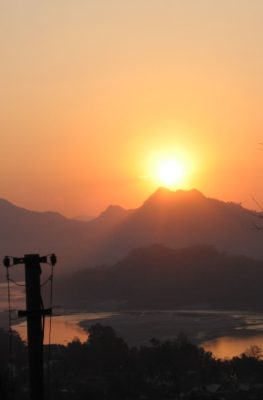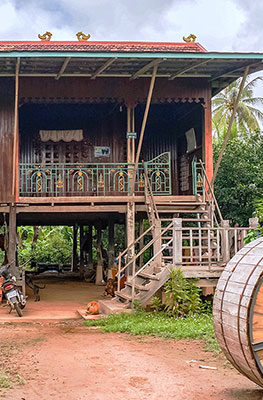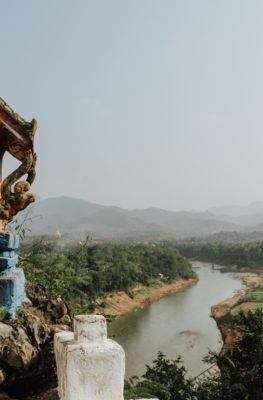Published on May 8, 2015
The definition of a World Heritage Site is quite straightforward, notably a place, of outstanding cultural and/or natural value to humankind.
Most tourists to SE Asia are aware of the concept and able to mention one or more sites, though mostly limited to the famed ones. Quite a few sites, like the National Parks Mount Lorentz in Papua (Indonesia) or the Subterranean River Park on Palawan Island (the Philippines), remain fairly unknown. This being the reason of selecting a few of the unknown World Heritage Sites that deserve wider attention.
Therefore, in the prevailing article two sites have been selected that play second fiddle to its country’s prime or other prominent sites, respectively in Laos and in Thailand.

Wat Xieng Thong, Luang Prabang, Laos; Source: http://vietnamuniquetours.com
LAOS
Landlocked and mountainous Laos is developing quietly insofar tourism is concerned. Compared to its principal neighbours, the country’s number of international tourist arrivals are modest, though growing steadily. It has two existing and one potential WHS – the “Plain of Jars”).
”Luang Prabang” is the country’s tourism magnet, filled with a collection of brilliant golden-capped temples, timber houses, rural French colonial buildings, charming boutique hotels and restaurants catering to ever increasing tourist numbers. One of the top attractions being monks from the various monasteries walking the streets at dawn, collecting alms of rice from locals and tourists alike. One can hardly imagine that this charmingly small city on the confluence of the mighty Mekong and the Nam Khan River was the capital until 1975.
No wonder that Lao’s 2nd World Heritage Site, down in the south at Champasak, with the longest name imaginable “Vat Phou and Associated Ancient Settlements within the Champasak Culture Landscape” faces stiff competition from the country’s premier site, Luang Prabang.

Vat Phou Temple Complex, Champasak, Laos; Source: http://commons.wikimedia.org
But those who undertake the journey to the ruined Khmer Temple Complex at the base of Mount Phou Kao, dating back to the 5th to 15th centuries, are vastly rewarded for their efforts. Admitted, Wat Phu doesn’t offer the same grandeur as the monumental Angkor Archeological Site in Cambodia, but its intimacy, tranquil environment and the ‘away of it all’ feeling gives the site a preternatural mythical atmosphere. Not in the least due to the crumbling buildings, mysterious, small stone pillars lining the paths to the temple and lofty trees that cloak much of the site. The complex is designed to convey the Hindu concept of the association between nature and the human race, presented in a symmetrical configuration of temples, tombs and waterworks spreading over some 10km. Last, but not least it is a living temple, still in use as a Buddhist sanctuary nowadays. Quite a few reasons to go, before it’s discovered by mainstream tourism.
THAILAND
Thailand has three cultural sites (“Ayutthaya”; “Sukhothai” and “Ban Chiang”) and two natural ones – with tongue twisting names for non-Thai speakers – the “Dong Phayayen – KhaoYai Forest Complex” and “Thungyai-HuaiKhaKhaeng Wildlife Sanctuary”. All five are important stops on tour itineraries nationwide, and reachable by an excellent network of highways. For those wishing to mix culture and nature, both Ayutthaya and the KhaoYai National Park are just a three- to four-hour drive from Bangkok. Both the forest and wildlife spots are said to contain some of Asia’s most unique species of birds and wildlife. Ban Chiang has been extensively restored with assistance from UNESCO and become an important stop on tours covering Northeast Thailand and neighbouring Lao PDR.

The Historic City of Sukhothai and Associated Historic Towns, Thailand;Source:http://attractionsworld.net
The Historic City of Sukhothai preceded Ayutthaya as the capital of the first Kingdom of Siam in the 13th and 14th centuries. It has a number of fine monuments, illustrating the beginnings of Thai architecture. The great civilisation, which evolved in the Kingdom of Sukhothai, absorbed numerous influences and ancient local traditions; the rapid assimilation of all these elements forged what is known as the ‘Sukhothai style’. The site has 193 ruins scattered in an area of about 70 square kilometres – making the place a major spot of historical importance, famous for its combination of Khmer and Sri Lankan style of architecture. Therefore, it became one of the most popular tourist attractions of Thailand.
The Ban Chiang Archaeological Site, is becoming increasingly popular, especially as it considered the most important primeval settlement so far discovered in South East Asia, by scholars. It is a prehistoric Bronze Age human inhabitation and burial site, at least 8 hectares in size. Research revealed that the site dates from 1500 BC and contains early evidence of settled agrarian occupation, wet rice culture, domestication of farm animals, ceramic manufacture, and bronze tool-making technology in South East Asia.
Many historical pots, household and other items, from over 4000 to 7000 years old have been unearthed and are on display at the next-door National Museum. These include distinctive highly varied ceramics known as the “Ban Chiang Ceramic Tradition.” Also included among the artefact collection are iron and bronze adornments and tools, and glass, shell, and stone objects. In addition there is an open-air museum around the actual archaeological digs.

A collection of ancient pottery found at Ban Chiang, exhibited at the site’s adjacent Museum;
Source: http://thaismile.jp
Ban Chiang is extraordinary given that prior to its discovery continental South East Asia was considered a cultural backwater during the Bronze Age; archaeological research at the site has revealed a fully developed Bronze Age metallurgy, though lacking the weaponry so often associated with it in Europe and the rest of the world. Because of the relatively continuous occupation of the site for perhaps thousands of years, the evolution of pre-metal to Bronze to Iron Age is traceable.
Once you have made it to Ban Chiang, don’t miss the opportunity to visit another unique archaeological excavation site, PhuKhumKhao(a two-hour drive, 150 km south of Ban Chiang).It is the place where petrified large sized dinosaur bones were detected by a Buddhist abbot in his temple’s compound in the 1970s. To date, the number of dinosaurs discovered have reached 6 samplings, with more than 630 pieces of bones, dating back 160 million years in time, with one individual skeleton almost entirely in one piece. There’s an air-conditioned and spacious Museum on a five-minute walk from the excavation with lots of information in English and impressive exhibits.

Phu Kum Khao dinosaurs’ excavation site, Kalasin, Isan, Thailand; Source: http://Thaitraveldreams.com
For those appreciating the cultural and religious development of South East Asia, the remote Vat Phou Temple Complex in Laos and Bang Chiang Archaeological site in Thailand
Conspicuously are ‘must see’ destinations






